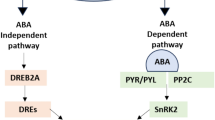Summary
There was no correlation between the quantity of exopolysaccharide produced and acetylene reduction activity by Rhizobium spp. or by Bradyrhizobium spp. (Cajanus). The exopolysaccharide-defective mutants of Rhizobium sp. strain P 116 either failed to nodulate or showed a decrease in effectiveness. The deficiency in exopolysaccharide production was corrected by the addition of purified exopolysaccharide from the parent strain, or from Bradyrhizobium sp. strain P 149 or S24 isolated from pigeonpea (Cajanus cajan) and mungbean (Vigna radiata), respectively. However, the nodules so formed were not fully effective compared to those formed by the parent strain.
Similar content being viewed by others
References
Chakravorty AK, Zurkowski W, Shine J, Rolfe BG (1982) Symbiotic nitrogen fixation: molecular cloning of Rhizobium genes involved in exopolysaccharide synthesis and effective nodulation. J Mol Appl Genet 1:585–596
Chen H, Batley M, Redmond JW, Rolfe BG (1985) Alternation of effective nodulation properties of a fast growing broad host range Rhizobium due to changes in exopolysaccharide synthesis. J Plant Physiol 120:331–349
Dahiya JS, Khurana AL (1981) “Chillum Jar” — a better technique for screening of rhizobia under summer conditions. Plant and Soil 83:299–302
Djordjevic SP, Chen H, Batley M, Redmond JW, Rolfe BG (1987) Nitrogen fixation ability of exopolysaccharide synthesis mutants of Rhizobium sp. strain NGR 234 and Rhizobium trifolii is restored by the addition of homologous exopolysaccharides. J Bacteriol 168:53–60
Dudman WF (1977) The role of surface polysaccharide in natural environments. In: Sutherland I (ed) Surface carbohydrates of the prokaryote cell. Academic Press, New York, pp 357–414
Anan TM, Hirsch AM, Leigh JA, Johanson E, Kuldau GA, Deogan S, Walker GC, Signer ER (1985) Symbiotic mutants of Rhizobium meliloti that uncouple plant from bacterial differentiation. Cell 40:869–877
Gupta RP, Ghai J, Ghai SK, Kalra MS (1982) Studies on nitrogenase activity and exopolysaccharide production in Rhizobium isolates of mungbean (Vigna radiata L.) and gram (Cicer arietinum Linn). Indian J Exp Biol 20:835–837
Halverson LJ, Stacey G (1986) Signal exchange in plant microbe interactions. Microbiol Rev 50:193–225
Hardy RWF, Holstein RD, Jackson EK, Burns RC (1968) The acetyleneethylene assay for nitrogen fixation: Laboratory and field evaluation. Plant Physiol 43:1185–1207
Hollingswowth SP, Hollingsworth RI, Dazzo FB (1989) Host range related structural features of the acidic extracellular polysaccharides of Rhizobium trifolii and Rhizobium leguminosarum. J Biol Chem 264:1461–1466
Leigh JA, Signer ER, Walker GC (1985) Exopolysaccharide deficient mutants of Rhizobium meliloti that form ineffective nodules. Proc Natl Acad Sci USA 82:6231–6235
Leigh JA, Reed JW, Hanks JF, Hirsch AM, Walker GC (1987) Rhizobium meliloti mutants that fail to succinylate their calcoflour binding exopolysaccharide are defective in nodule invasion. Cell 51:579–587
Müller P, Hynes M, Kapp D, Niehaus K, Pühler A (1988) Two classes of Rhizobium meliloti infection mutants differ in exopolysaccharide production and in coinoculation properties with nodulation mutants. Mol Gen Genet 211:17–26
Postgate JR (1971) Chemistry and biochemistry of nitrogen fixation. Plenum Press, London
Rajgopal SN, Rai PV (1986) Chemical characteristics of Rhizobium japonicum kirch extracellular polysaccharides. Indian J Exp Biol 24:710–713
Rolfe BG, Djordjevic M, Scott KF, Hughes JE, Jones JB, Gresshoff PM, Cen Y, Dudman WF, Zurkowski W, Shine J (1981) Analysis of nodule forming ability of fast growing Rhizobium strains. In: Gibson AN, Newston WF (eds) Current perspective in nitrogen fixation. Australian Academy of Science, Sydney, pp 142–145
Sanders RE, Carlson RW, Albersheim A (1978) Rhizobium mutant incapable of nodulation and normal polysaccharide secretion. Nature (Lond) 271:240–242
Sanders RE, Raleigh E, Signer ER (1981) Lack of correlation between extracellular polysaccharide and nodulation ability in Rhizobium. Nature (Lond) 292:148–149
Sharma PK, Lakshminarayana K (1989). Effect of high temperature on plasmid curing of Rhizobium spp. in relation to nodulation of pigeonpea [Cajanus cajan (L) Millsp]. Biol Fertil Soils 8:75–79
Simon R, Priefer U, Pühler A (1983) A broad host range mobilization system for in vivo genetic engineering random and site specific mutagenesis in gram negative bacteria. Biotechnology 1:784–791
Vincent JM (1970) A manual for the practical study of the root nodule bacteria. International Biological Programme Handbook, Blackwell, Oxford
Author information
Authors and Affiliations
Rights and permissions
About this article
Cite this article
Singh, S.K., Dudeja, S.S. & Khurana, A.L. Rhizobium sp. exopolysaccharide production, nodulation, and acetylene reduction activity (N2-fixation) in pigeon pea (Cajanus cajan L.). Biol Fertil Soils 11, 30–33 (1991). https://doi.org/10.1007/BF00335830
Received:
Issue Date:
DOI: https://doi.org/10.1007/BF00335830




